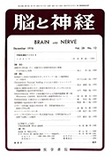- 有料閲覧
- 文献概要
「中枢性頭位眩暈」というと,神経耳科学の領域では,すぐにピーンとくる言葉であるが,脳神経外科学,神経内科学をご專攻の研究者には,あまりおなじみではないと思うので僭越ながら簡単にまとめて解説してみたい。
"ある特定の頭の位置(たとえば右を下にした頭位)をとると,たちまち,めまいが起る。つまり"critical head position"をもつためまい",これを頭位眩暈と呼んでいる。頭位眩暈positional vertigoには,2種類あって,末梢性頭位眩暈(peripheral type,末梢前庭器官に障告があつておこる)と,中枢性頭位眩暈(central type,小脳など中枢前庭系の障害によっておこる)に分けられている。このように分けたのは英国学派のDix, Hallpike, Cawthorneら(1954)であり,とくに末梢性頭位眩暈は,耳石器の関与が大で,いわゆる"良性発作性頭位眩暈positional nystagmus (vertigo) of the be—nign paroximal type"と呼ばれており,ご存知の方も多いと思う。一方,中枢性頭位眩暈については,Dix, Hallpikeらよりも,ずっと前,1902年にBrunsによって報告されていた。Brunsは第4脳室に柄をもつCysti—cercosisの症例で,ある頭位をとらせると激しいめまい,頭痛,嘔吐をおこしたのである。この発表以降Oppen—heimは,彼のLehrbuch der NervenkrankheitenにBrunssche Symptomとして1つの診断的価値ある症状として述べ,さらに柄を有しないで第4脳室に固着しているCysticercusの場合でも同様な症状が起ると,次のように述べている。…Brunssche Symptom,…es nicht nur beim freien, sondern auch bei dem fixierten Cy—sticercus ventriculi quarti und seltener auch unter anderen Verhaeltnissen vorkommt.Bruns症候群は,ヨーロッパだけではなく米国においても,有名なDe Jongの大著The Neurological Examinationに次のように説明されている。Bruns′syndrome consists of vertigo, vomiting, headache, and visual disturbances on changing of position of the head; this is usually associated with a cysticercus infection of the fourth ventricle or with midline tumor of the cerebellum, and the symptoms are probably the result of distur—bances of function of the vestibular pathways in the brain stem.すなわち頭の位置を変えることによって,めまい,頭痛,嘔吐などを生じる。つまり,頭位眩量positional vertigoと同じ内容で,原因が中枢にあるのである。ここにおいて,英国学派のいう中枢性頭位眩暈positional vertigo of central typeとBruns症候群とは,同じ現象を意味しており,同意語Synonymと解釈してよいと思う。
Copyright © 1976, Igaku-Shoin Ltd. All rights reserved.


